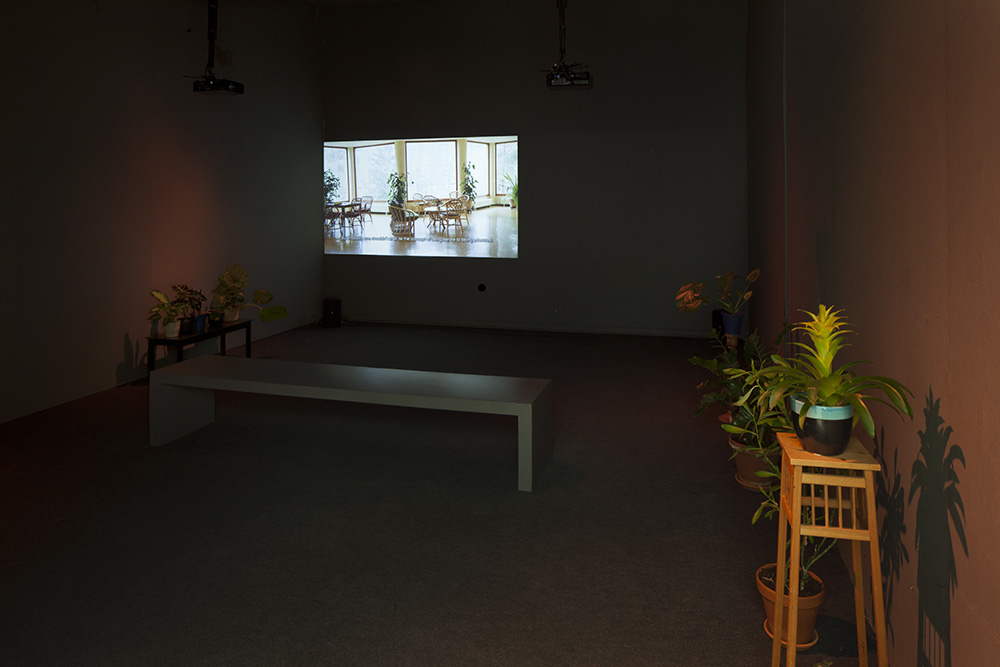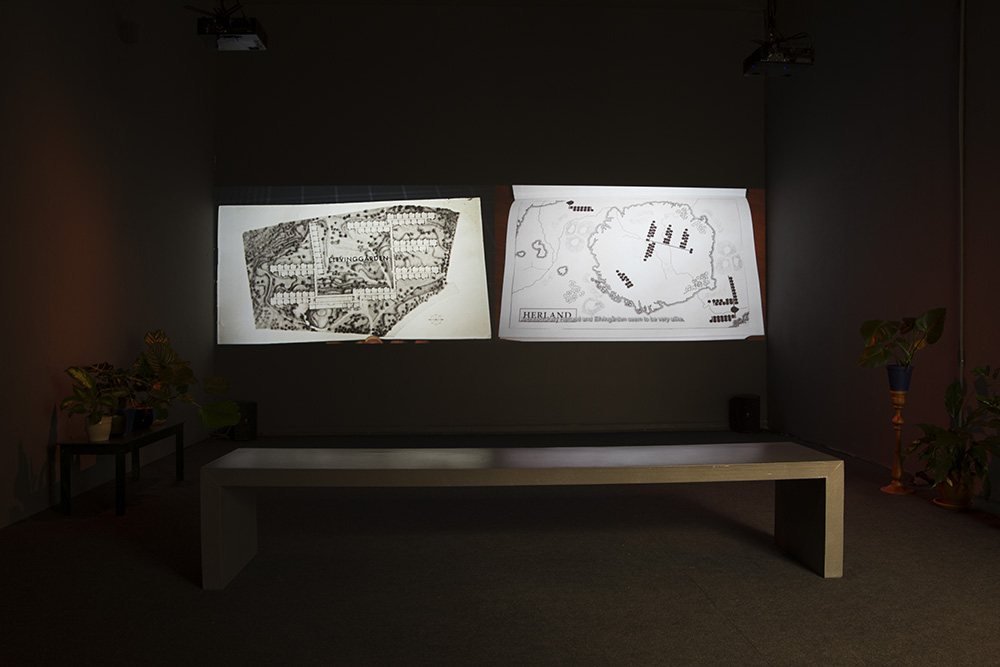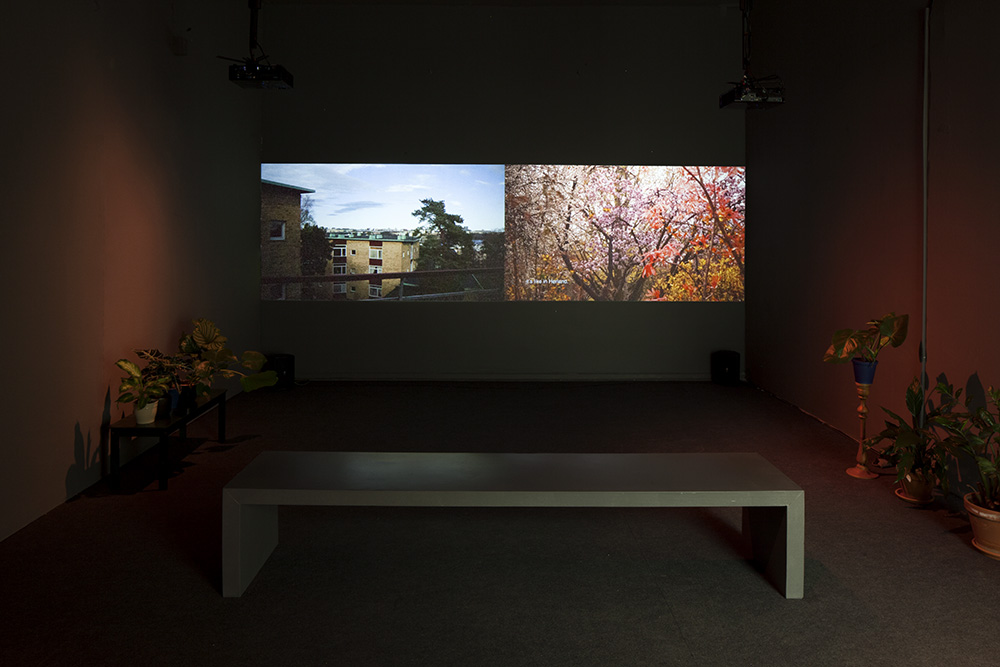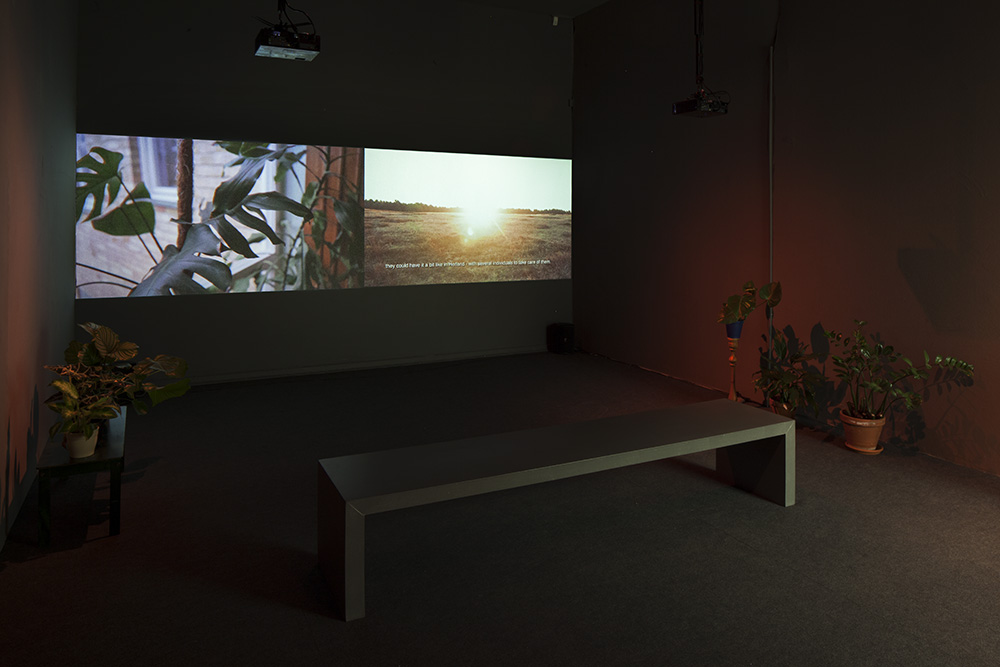2-kanalsvideo projection, HD, ljud, 13.39 min, växter, piedestaler i blandade material, rosa ljussättning. 2014-2016.

Installationsvy från utställningen Oomph – Kvinnorna som satte färg på Sverige på Malmö Konstmuseum. Fotograf: Jenny Ekholm Bailes.

Installationsvy från utställningen Oomph – Kvinnorna som satte färg på Sverige på Malmö Konstmuseum. Fotograf: Jenny Ekholm Bailes.

Installationsvy från utställningen Oomph – Kvinnorna som satte färg på Sverige på Malmö Konstmuseum. Fotograf: Jenny Ekholm Bailes.

Installationsvy från utställningen Oomph – Kvinnorna som satte färg på Sverige på Malmö Konstmuseum. Fotograf: Jenny Ekholm Bailes.
Text in English below
Videoverket utspelar sig på två platser; ett kollektivhus kallat Elfvinggården byggt 1940 för yrkesverksamma, ensamstående kvinnor och på en fiktiv plats som heter Jungfrulandet. Verket ställer frågor om situationen för kvinnor från 1940-talet fram till idag och om vilka platser eller miljöer som möjliggör kollektiv förändring.
Verket är ett samarbete med en läsgrupp på Elfvinggården bestående av sex kvinnor som bor i huset. Tillsammans har de läst sci-fi-romanen Jungfrulandet från 1915 av den amerikanska författaren Charlotte Perkins Gilman – ett utopiskt feministiskt narrativ som utspelar sig i ett isolerat land där bara kvinnor lever som reproducerar sig genom jungfrufödsel. Romanen undersöker hur ett samhälle utan uppdelningen av två binära könsidentiteter skulle kunna se ut.
Samtalen i läsgruppen skiftar mellan att reflektera över sin egen situation och andra kvinnors situation i ett historiskt och feministiskt perspektiv i relation till den utopiska vision som skildras i romanen. Men läsningen inspirerar också till fler tankar om hur kollektivhuset skulle kunna fungera i framtiden.
Videon pendlar mellan att visa miljöer från kollektivhuset som i huvudsak har stått sig kvar sedan det byggdes och den fiktiva platsen i romanen, som deltagarna i läsgruppen föreställer sig den. I installationen möts båda platserna genom växtarrangemang från kollektivhuset i ett rosa ljus liknande det som finns i Jungfrulandet.
Medverkande i läsgruppen Anita Sand, Eva Nikell, Gunnel Stenberg, Elisabet Berglund, Maria Munk och Veronica Ylikotila. Medverkande skådespelare med röster i videoverket (baserat på manus från samtalet i läsgruppen): : Clara Hedar, Lena Kronberg, Anne Marte Overaa, Sandra Louise Lindqvist, Karin Bertling och Carina Ehrenholm.
The piece unfolds in two places; a collective house called Elfvinggården built in 1940 for professional, single women and in a fictional place called Herland. It poses questions about the situation for women from the 1940’s up until today and about which places or environments that make collective change possible.
The video piece has been developed together with a reading group at Elfvinggården consisting of six women who live in the house. Together they have read the sci-fi novel Herland from 1915 by the American author Charlotte Perkins Gilman- a utopian feminist narrative that unfolds in an isolated land where only females live that reproduce themselves through virgin birth. The novel examines how a society without the division of two binary gender identities could look.
The conversations in the reading group shift between reflecting on their own situation and other females situation in a historical and feminist perspective in relation to the utopian vision portrayed in the novel. But the reading also inspires more thoughts on how the collective house could function in the future.
The video oscillates between showing environments from the collective house that has mainly stayed the same since it was built and the fictional place in the novel, as the participants in the reading group imagine it. In the installation both places meet through plant arrangements from the collective house in a pink light similar to the one that can be found in Herland.
Participants in the reading group: Anita Sand, Eva Nikell, Gunnel Stenberg, Elisabet Berglund, Maria Munk and Veronica Ylikotila.
Participants with voices in the video work (based on script from the conversation in the reading group): Clara Hedar, Lena Kronberg, Anne Marte Overaa, Sandra Louise Lindqvist, Karin Bertling and Carina Ehrenholm.